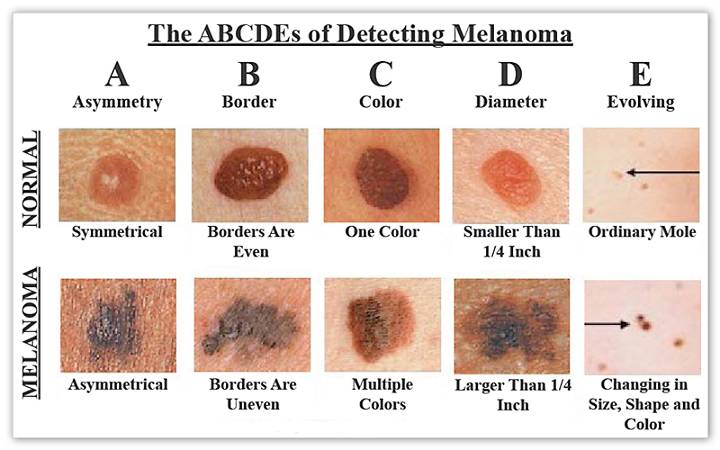Skin cancer is among the most frequent kinds of cancer worldwide. It happens when skin cells proliferate uncontrolled owing to DNA damage, which is commonly caused by ultraviolet (UV) radiation from the sun or tanning beds. There are three primary forms of skin cancer:
- Basal Cell Carcinoma (BCC): This is the most common type and usually appears in sun-exposed areas.
- Squamous Cell Carcinoma (SCC): This type also typically develops on sun-exposed skin.
- Melanoma: Though less common, melanoma is the most dangerous form of skin cancer and can spread to other parts of the body.
Key Signs of Skin Cancer
Identifying skin cancer early can significantly improve treatment outcomes. Here are the primary signs to watch for:
1. New or Changing Moles
A new or changed mole is one of the most obvious indications of skin cancer. This may involve variations in size, shape, color, or elevation. The ABCDE rule will help you remember what to look for:
- A — Asymmetry: One half of the mole doesn’t match the other half.
- B — Border: The edges are irregular, scalloped, or poorly defined.
- C — Color: The color is not uniform and may include shades of brown, black, pink, red, white, or blue.
- D — Diameter: The mole is larger than 6mm (about the size of a pencil eraser), though melanomas can be smaller.
- E — Evolving: The mole changes in size, shape, color, or begins to bleed or itch.
2. Persistent Itching or Tenderness
If you have a mole or patch on your skin that itches, feels painful, or causes discomfort, see a dermatologist. Persistent soreness is a red flag that should not be overlooked.
3. Non-Healing Sores or Ulcers
Any sore or ulcer that does not heal in a few weeks or reopens after healing may indicate skin cancer. This is especially true for lesions that bleed, ooze, or get crusty.
4. Red or Pink Growths
Look for red or pink growths with elevated edges and a center indentation. These can be indicative of basal cell cancer. Such growths may also have blood vessels visible on the surface.
5. Flat, Scaly Patches
Flat, scaly areas of skin that are red or brown may suggest squamous cell cancer. These spots can crust or bleed and are commonly found on the face, ears, neck, lips, and backs of the hands.
6. Changes in Pigmentation
Any abrupt shifts in the pigmentation of your skin, such as darkening or the formation of new, dark spots, should be investigated. This is especially important if the pigmentation extends beyond the boundaries of a mole or area.
Protecting Your Skin
Preventive measures are essential to reduce your risk of skin cancer:
- Use Sunscreen: Apply a broad-spectrum sunscreen with an SPF of at least 30 every day, even on cloudy days.
- Wear Protective Clothing: Cover your skin with hats, sunglasses, and long-sleeved clothing when outdoors.
- Seek Shade: Avoid direct sun exposure, especially between 10 a.m. and 4 p.m., when UV rays are strongest.
- Avoid Tanning Beds: Tanning beds significantly increase your risk of skin cancer.
Regular Skin Checks
Regular self-examinations can help you detect skin cancer early. Examine your skin from head to toe, including places not exposed to sunlight. Schedule a yearly skin exam with a dermatologist to ensure that any abnormal changes are identified and handled immediately.
When to See a Dermatologist
If you notice any of the signs mentioned above or have any concerns about your skin, don’t hesitate to make an appointment with a dermatologist. Early detection and treatment can make all the difference.
At ECOS Clinic, we are committed to providing comprehensive skin care and educating our patients about skin health. If you have any questions or need to schedule a consultation, please contact us.






Comments